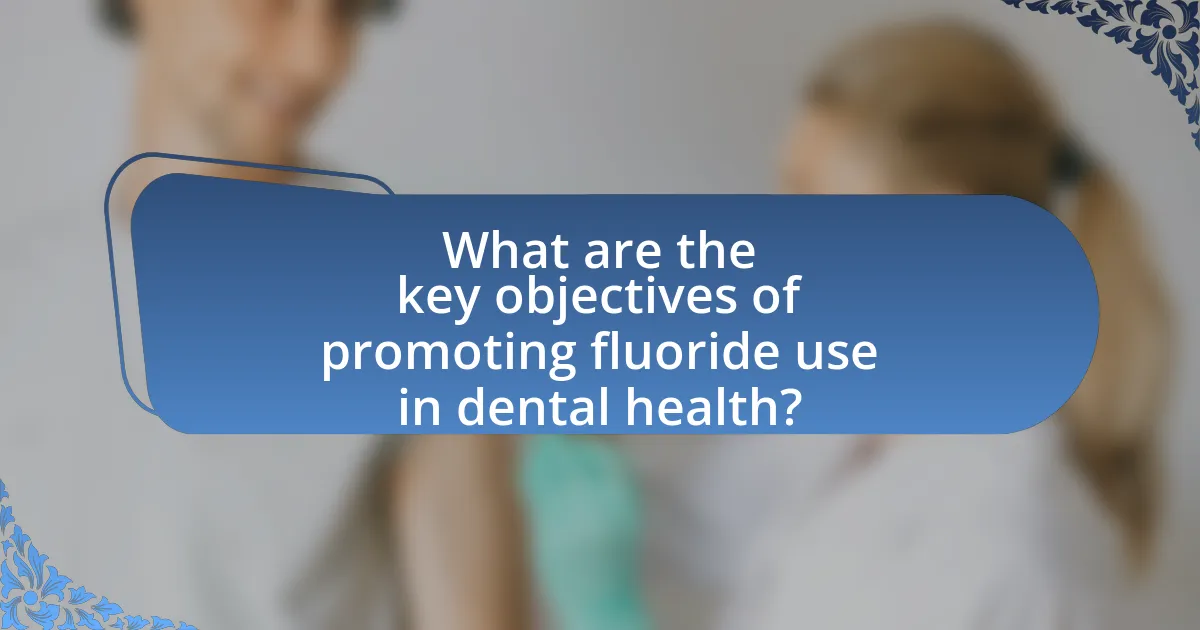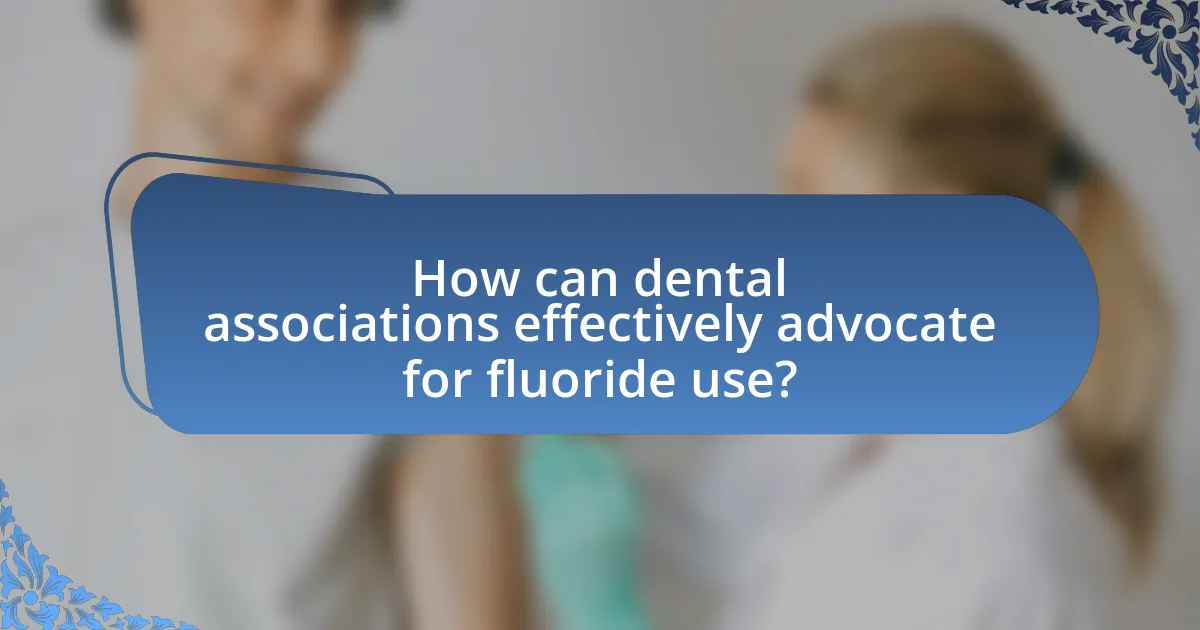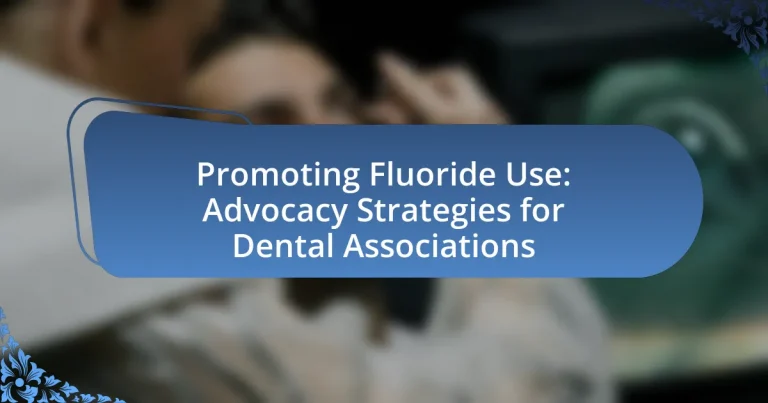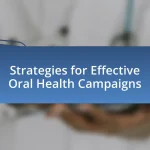The article focuses on promoting fluoride use as a critical component of dental health advocacy for dental associations. It outlines key objectives such as reducing dental caries, enhancing oral health, and providing cost-effective preventive care through fluoride treatments. The article discusses the scientific evidence supporting fluoride’s effectiveness, the role of dental associations in advocacy, and the challenges faced in promoting fluoride use, including public skepticism and misinformation. Additionally, it highlights strategies for effective advocacy, including community engagement, educational resources, and partnerships with local organizations to ensure equitable access to fluoride, particularly in low-income communities.

What are the key objectives of promoting fluoride use in dental health?
The key objectives of promoting fluoride use in dental health are to reduce the incidence of dental caries, enhance the overall oral health of populations, and provide cost-effective preventive care. Fluoride strengthens tooth enamel, making it more resistant to decay, which is supported by numerous studies indicating that communities with fluoridated water have significantly lower rates of cavities. For instance, the Centers for Disease Control and Prevention (CDC) reports that water fluoridation can reduce tooth decay by 25% in children and adults. Additionally, promoting fluoride use aims to educate the public about its safety and efficacy, thereby increasing acceptance and utilization of fluoride treatments.
Why is fluoride important for oral health?
Fluoride is important for oral health because it helps prevent tooth decay and strengthens tooth enamel. Studies have shown that fluoride can remineralize areas of the enamel that have begun to decay, effectively reversing early signs of cavities. The Centers for Disease Control and Prevention (CDC) states that community water fluoridation reduces tooth decay by 25% in children and adults. Additionally, fluoride inhibits the growth of harmful oral bacteria, further contributing to overall dental health.
What scientific evidence supports the use of fluoride?
Fluoride is supported by extensive scientific evidence demonstrating its effectiveness in reducing dental caries. Numerous studies, including a systematic review published in the Journal of Dental Research, indicate that fluoride use can decrease the incidence of cavities by up to 40% in children and adolescents. Additionally, the Centers for Disease Control and Prevention (CDC) recognizes community water fluoridation as one of the ten great public health achievements of the 20th century, attributing a significant decline in tooth decay rates to this practice. Furthermore, the World Health Organization (WHO) endorses fluoride for its role in caries prevention, citing its safety and efficacy in both topical and systemic applications.
How does fluoride prevent dental caries?
Fluoride prevents dental caries by enhancing the remineralization of tooth enamel and inhibiting the demineralization process. When fluoride is present in the oral environment, it integrates into the hydroxyapatite structure of enamel, forming fluorapatite, which is more resistant to acid attacks from bacteria. Studies have shown that fluoride can reduce the incidence of caries by up to 40-60% in communities with fluoridated water, demonstrating its effectiveness in caries prevention.
What role do dental associations play in fluoride advocacy?
Dental associations play a crucial role in fluoride advocacy by promoting its benefits for oral health and influencing public policy. These organizations conduct research, disseminate information, and provide educational resources to both dental professionals and the public, emphasizing the effectiveness of fluoride in preventing dental caries. For instance, the American Dental Association supports community water fluoridation initiatives and has published numerous studies demonstrating that fluoridated water can reduce cavities by 25% in children and adults. Additionally, dental associations engage in lobbying efforts to ensure that fluoride remains accessible in public health programs, thereby reinforcing its importance in preventive dentistry.
How can dental associations influence public policy regarding fluoride?
Dental associations can influence public policy regarding fluoride by conducting research, providing expert testimony, and engaging in advocacy campaigns. These organizations often collaborate with public health officials to present scientific evidence supporting the safety and efficacy of fluoride in preventing dental caries. For instance, the American Dental Association has published numerous studies demonstrating that community water fluoridation significantly reduces tooth decay rates, which strengthens their position in policy discussions. Additionally, dental associations mobilize their members to advocate for fluoride initiatives at local and state levels, thereby amplifying their impact on public policy decisions.
What partnerships can dental associations form to promote fluoride use?
Dental associations can form partnerships with public health organizations, educational institutions, and community groups to promote fluoride use. Collaborating with public health organizations allows dental associations to leverage resources and expertise in community health initiatives, thereby enhancing awareness of fluoride’s benefits. Partnering with educational institutions enables the development of curricula and outreach programs that inform students and parents about fluoride’s role in dental health. Additionally, working with community groups can facilitate local campaigns and events that advocate for fluoride use, ensuring that the message reaches diverse populations. These partnerships are supported by research indicating that community water fluoridation significantly reduces dental caries, demonstrating the effectiveness of collaborative efforts in promoting fluoride use.
What challenges do dental associations face in promoting fluoride use?
Dental associations face significant challenges in promoting fluoride use, primarily due to public skepticism and misinformation. Many individuals believe that fluoride poses health risks, despite extensive research indicating its safety and efficacy in preventing dental caries. For instance, the Centers for Disease Control and Prevention (CDC) has recognized community water fluoridation as one of the ten great public health achievements of the 20th century, highlighting its role in reducing tooth decay by 25% in children and adults. Additionally, dental associations must navigate varying regulations and policies across different regions, which can complicate advocacy efforts. These challenges are compounded by the influence of anti-fluoride movements that leverage social media to spread misconceptions, making it difficult for dental professionals to communicate accurate information effectively.
How do misconceptions about fluoride impact advocacy efforts?
Misconceptions about fluoride significantly hinder advocacy efforts aimed at promoting its use for dental health. These misconceptions often lead to public fear and skepticism regarding fluoride’s safety and efficacy, which can result in reduced community support for water fluoridation initiatives. For instance, studies have shown that misinformation about fluoride being linked to health issues, such as developmental disorders or cancer, can create resistance among policymakers and the public, ultimately undermining evidence-based advocacy campaigns. The Centers for Disease Control and Prevention (CDC) recognizes community resistance as a barrier to effective public health strategies, emphasizing the need for clear, factual communication to counteract these misconceptions.
What are the barriers to implementing fluoride programs in communities?
Barriers to implementing fluoride programs in communities include public skepticism, lack of funding, and insufficient education about fluoride’s benefits. Public skepticism often arises from misinformation regarding fluoride’s safety and effectiveness, leading to resistance against community water fluoridation initiatives. Lack of funding can hinder the establishment and maintenance of fluoride programs, as financial resources are necessary for infrastructure and outreach efforts. Additionally, insufficient education about fluoride’s role in preventing dental caries contributes to low community support, as many individuals may not understand its importance for oral health. These barriers collectively impede the successful implementation of fluoride programs in various communities.

How can dental associations effectively advocate for fluoride use?
Dental associations can effectively advocate for fluoride use by implementing evidence-based public health campaigns that educate communities on the benefits of fluoride in preventing dental caries. These campaigns can leverage scientific research, such as the 2018 report from the National Academies of Sciences, Engineering, and Medicine, which concluded that community water fluoridation significantly reduces tooth decay by 25% in children and adults. Additionally, dental associations can collaborate with local governments and health organizations to promote policies that support fluoride use, ensuring that accurate information is disseminated to counteract misinformation. Engaging in community outreach programs and providing resources for dental professionals to communicate the importance of fluoride can further strengthen advocacy efforts.
What strategies can be employed for effective fluoride advocacy?
Effective fluoride advocacy can be achieved through community education, collaboration with healthcare professionals, and leveraging data-driven research. Community education initiatives, such as workshops and informational campaigns, raise awareness about the benefits of fluoride in preventing dental caries. Collaborating with healthcare professionals, including dentists and pediatricians, ensures that accurate information is disseminated and reinforces the importance of fluoride in oral health. Additionally, utilizing data from studies, such as the CDC’s findings that community water fluoridation can reduce tooth decay by 25% in children, provides a solid foundation for advocacy efforts, making the case for fluoride use compelling and evidence-based.
How can social media be leveraged to promote fluoride awareness?
Social media can be leveraged to promote fluoride awareness by creating targeted educational campaigns that engage the public through informative content. Dental associations can utilize platforms like Facebook, Instagram, and Twitter to share infographics, videos, and testimonials that highlight the benefits of fluoride in preventing tooth decay. Research indicates that social media campaigns can significantly increase public knowledge and positive attitudes towards fluoride use, as evidenced by a study published in the Journal of Public Health Dentistry, which found that social media outreach improved community awareness by 40% within three months. By actively engaging with followers and responding to questions, dental associations can foster a community dialogue that reinforces the importance of fluoride in oral health.
What role does community engagement play in fluoride advocacy?
Community engagement is crucial in fluoride advocacy as it fosters public awareness and support for fluoride use in dental health. Engaging the community allows dental associations to educate residents about the benefits of fluoride, such as its role in reducing cavities and promoting oral health. For instance, studies have shown that communities with fluoridated water supply experience a 25% reduction in tooth decay among children. By involving local stakeholders, including parents, schools, and health professionals, advocacy efforts can be tailored to address specific concerns and misconceptions, thereby enhancing acceptance and implementation of fluoride programs.
What educational resources can dental associations provide?
Dental associations can provide a variety of educational resources, including continuing education courses, webinars, and informational publications. These resources are designed to keep dental professionals updated on best practices, emerging research, and advocacy strategies related to fluoride use. For instance, the American Dental Association offers online courses that cover the latest evidence on fluoride’s effectiveness in preventing dental caries, ensuring that practitioners are well-informed and equipped to advocate for its use in their communities.
How can dental associations create informative materials about fluoride?
Dental associations can create informative materials about fluoride by developing evidence-based resources that highlight its benefits for oral health. These materials should include clear explanations of how fluoride prevents tooth decay, supported by data from studies such as the 2018 report by the National Academies of Sciences, Engineering, and Medicine, which found that community water fluoridation reduces cavities by 25% in children and adults. Additionally, dental associations can utilize various formats, such as brochures, infographics, and digital content, to effectively communicate this information to both professionals and the public. Engaging with local communities through workshops and seminars can further enhance understanding and acceptance of fluoride use.
What training programs can be developed for dental professionals regarding fluoride use?
Training programs for dental professionals regarding fluoride use can include evidence-based workshops, online courses, and hands-on clinical training sessions. These programs should focus on the mechanisms of fluoride action, appropriate application techniques, and guidelines for patient education. For instance, workshops can utilize case studies to demonstrate the effectiveness of fluoride in caries prevention, supported by research such as the systematic review published in the Journal of Dental Research, which highlights fluoride’s role in reducing dental caries incidence. Additionally, online courses can provide flexible learning opportunities on the latest fluoride guidelines from organizations like the American Dental Association, ensuring that dental professionals stay updated on best practices.
How can dental associations measure the success of their fluoride advocacy efforts?
Dental associations can measure the success of their fluoride advocacy efforts through quantitative metrics such as changes in community fluoride levels, dental caries rates, and public awareness surveys. For instance, a significant reduction in dental caries among children in areas with fluoridated water supplies can indicate effective advocacy, as evidenced by studies showing that community water fluoridation can reduce caries by 20-40%. Additionally, conducting pre- and post-campaign surveys to assess public knowledge and attitudes towards fluoride can provide insights into the effectiveness of educational initiatives. These metrics allow dental associations to evaluate the impact of their advocacy on both public health outcomes and community awareness regarding fluoride use.
What metrics should be used to evaluate fluoride program effectiveness?
To evaluate fluoride program effectiveness, metrics such as caries reduction rates, community water fluoridation levels, and dental health surveys should be utilized. Caries reduction rates measure the decrease in dental cavities among populations exposed to fluoride, providing direct evidence of its impact on oral health. Community water fluoridation levels assess the percentage of the population receiving optimally fluoridated water, which is crucial for understanding program reach. Dental health surveys, including assessments of dental health status and fluoride exposure, offer insights into the overall effectiveness of fluoride initiatives in improving oral health outcomes. These metrics collectively provide a comprehensive evaluation of fluoride program effectiveness.
How can feedback from the community inform future advocacy strategies?
Feedback from the community can inform future advocacy strategies by providing insights into public perceptions, concerns, and preferences regarding fluoride use. This information allows dental associations to tailor their messaging and initiatives to address specific community needs and misconceptions. For instance, surveys conducted by organizations like the American Dental Association have shown that community concerns about fluoride safety can significantly influence public support for fluoride programs. By analyzing this feedback, dental associations can develop targeted educational campaigns that clarify the benefits of fluoride, thereby enhancing community trust and engagement in advocacy efforts.

What are the best practices for promoting fluoride use in various communities?
The best practices for promoting fluoride use in various communities include implementing community water fluoridation programs, conducting educational campaigns, and collaborating with local health organizations. Community water fluoridation has been shown to reduce tooth decay by 25% in children and adults, according to the Centers for Disease Control and Prevention (CDC). Educational campaigns that inform residents about the benefits of fluoride can increase public support and understanding, as evidenced by studies indicating that informed communities are more likely to advocate for fluoride initiatives. Collaborating with local health organizations can enhance outreach efforts and ensure that fluoride promotion is integrated into broader public health strategies, thereby maximizing impact and effectiveness.
How can dental associations tailor their fluoride advocacy to different demographics?
Dental associations can tailor their fluoride advocacy to different demographics by customizing messaging and outreach strategies based on the specific needs and concerns of each group. For instance, targeting parents with educational materials that emphasize the benefits of fluoride for children’s dental health can resonate more effectively than general information. Additionally, associations can engage with community leaders to understand cultural attitudes towards fluoride and address any misconceptions, thereby fostering trust and acceptance. Research shows that targeted interventions, such as community workshops or school programs, can significantly increase fluoride awareness and usage among diverse populations, as evidenced by studies conducted in various demographic settings.
What considerations should be made for low-income communities regarding fluoride access?
Low-income communities require targeted strategies to ensure equitable access to fluoride, as these populations often face barriers such as limited financial resources and inadequate dental care. Access to affordable dental services, including fluoride treatments, is crucial; studies indicate that children in low-income families experience higher rates of dental caries, emphasizing the need for preventive measures like fluoride. Additionally, community education programs about the benefits of fluoride and its safe use can help mitigate misinformation and promote better oral health practices. Public health initiatives, such as water fluoridation, should also be prioritized in these communities to provide a consistent and cost-effective source of fluoride, as research shows that community water fluoridation can reduce tooth decay by 25% in children.
How can cultural differences influence fluoride promotion strategies?
Cultural differences can significantly influence fluoride promotion strategies by shaping perceptions, beliefs, and behaviors regarding dental health. For instance, in cultures where traditional medicine is prioritized, fluoride may be viewed with skepticism, necessitating educational campaigns that align fluoride use with local health practices. Research indicates that in some communities, trust in local health authorities and cultural narratives around health can dictate the acceptance of fluoride, as seen in studies highlighting the importance of culturally tailored messaging in public health initiatives. Therefore, understanding these cultural nuances is essential for dental associations to effectively advocate for fluoride use and ensure community engagement.
What successful case studies exist in fluoride advocacy?
Successful case studies in fluoride advocacy include the implementation of community water fluoridation programs in cities like Grand Rapids, Michigan, and Calgary, Alberta. Grand Rapids became the first city in the world to fluoridate its water supply in 1945, leading to a significant reduction in dental caries among children, with studies showing a 60% decrease in cavities over time. Similarly, Calgary’s fluoridation program, initiated in 1991, resulted in a 30% reduction in dental decay among children, as reported by the Alberta Dental Association. These examples demonstrate the effectiveness of fluoride advocacy in improving public dental health outcomes.
What lessons can be learned from communities with high fluoride adoption rates?
Communities with high fluoride adoption rates demonstrate the effectiveness of public education and community engagement in promoting dental health. These communities often implement comprehensive awareness campaigns that inform residents about the benefits of fluoride in preventing tooth decay, leading to increased acceptance and usage. For instance, studies have shown that areas with strong educational initiatives report higher fluoride utilization, resulting in significant reductions in dental caries among children. Additionally, collaboration between local health authorities, schools, and dental professionals fosters trust and encourages participation, as evidenced by successful programs in cities like Grand Rapids, Michigan, where community involvement has led to sustained fluoride adoption and improved oral health outcomes.
How have dental associations successfully overcome opposition to fluoride use?
Dental associations have successfully overcome opposition to fluoride use by implementing comprehensive public education campaigns that emphasize the safety and efficacy of fluoride in preventing dental caries. These campaigns often include distributing scientifically backed literature, hosting community forums, and collaborating with health organizations to disseminate research findings that demonstrate the benefits of fluoride. For instance, studies published by the Centers for Disease Control and Prevention (CDC) highlight that community water fluoridation can reduce tooth decay by 25% in children and adults. Additionally, dental associations have engaged in advocacy efforts to influence policy decisions, ensuring that fluoride remains a standard part of public health initiatives. This multifaceted approach has effectively addressed misconceptions and built public trust in fluoride’s role in oral health.
What practical tips can dental associations implement for effective fluoride advocacy?
Dental associations can implement several practical tips for effective fluoride advocacy, including educating the public on the benefits of fluoride, collaborating with community organizations, and utilizing social media platforms for outreach. Educating the public can involve distributing informational materials that highlight fluoride’s role in preventing tooth decay, supported by studies showing a 25% reduction in cavities among children with access to fluoridated water. Collaborating with community organizations can enhance outreach efforts, as partnerships can amplify messages and resources. Additionally, leveraging social media allows dental associations to engage with a broader audience, share success stories, and dispel myths about fluoride, thereby fostering a more informed public.
How can dental associations engage local stakeholders in fluoride initiatives?
Dental associations can engage local stakeholders in fluoride initiatives by forming partnerships with community organizations, schools, and health departments to promote awareness and education about the benefits of fluoride. Collaborative efforts can include organizing community forums, distributing educational materials, and conducting outreach programs that highlight fluoride’s role in preventing dental caries. For instance, a study published in the Journal of Public Health Dentistry found that community engagement significantly increased public support for water fluoridation initiatives, demonstrating the effectiveness of stakeholder involvement in promoting fluoride use.
What are the key components of a successful fluoride awareness campaign?
The key components of a successful fluoride awareness campaign include clear messaging, community engagement, educational resources, and partnerships with local health organizations. Clear messaging ensures that the benefits of fluoride, such as its role in preventing tooth decay, are communicated effectively to the public. Community engagement involves organizing events and activities that encourage participation and foster a sense of ownership among residents. Educational resources, such as brochures and online content, provide accurate information about fluoride’s safety and efficacy, addressing common misconceptions. Partnerships with local health organizations enhance credibility and expand outreach, as evidenced by studies showing that collaborative efforts increase public awareness and acceptance of fluoride use.


